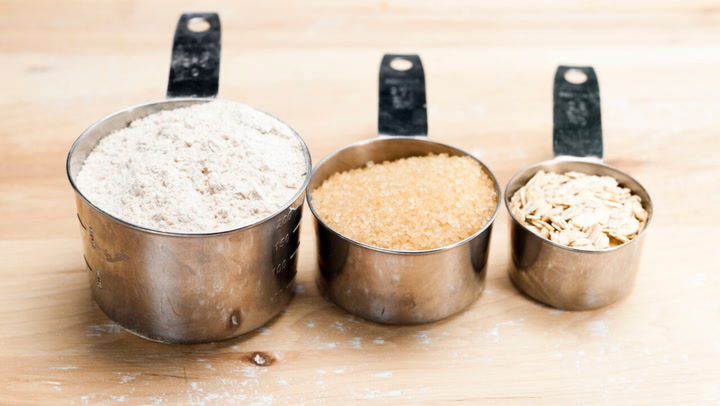Struggling with recipe measurements? You’re not alone. Whether you’re baking a cake, meal prepping, or trying an international recipe, converting grams to cups (or vice versa) can feel like solving a math puzzle. But here’s the catch: a cup of flour doesn’t weigh the same as a cup of sugar, and guessing can lead to dense cakes, runny sauces, or wasted ingredients. This guide breaks down how to convert grams to cups accurately, shares pro tips for hassle-free cooking, and recommends tools to simplify your kitchen experiments.
Cups To Grams Calculator
Enter the volume in cups below to calculate the weight in grams.
Result in Grams:
Why Grams to Cups Conversions Matter
Recipes use grams (weight) or cups (volume) based on regional preferences. For example:
- Grams: Preferred in Europe, Australia, and by professional chefs for precision.
- Cups: Common in the U.S. and Canada, but less accurate due to ingredient density variations.
A grams-to-cups converter bridges this gap, ensuring your recipes turn out right, whether you’re using a kitchen scale or measuring cups.

The Science Behind the Conversions
Weight (grams) measures mass, while volume (cups) measures space. Ingredients like flour, sugar, and butter have different densities, meaning:
- 1 cup of all-purpose flour ≈ 120–125 grams
- 1 cup of granulated sugar ≈ 200 grams
- 1 cup of butter ≈ 227 grams
Why this variability matters:
- Scooping flour directly from the bag packs it tightly, adding up to 20% more flour than a recipe requires.
- Brown sugar is denser than powdered sugar.
- Ingredients like oats or grated cheese can’t be measured uniformly without a scale.
How to Convert Grams to Cups Manually
While online tools are handy, understanding the basics empowers you to tweak recipes confidently.
Step 1: Identify the Ingredient’s Density
Refer to a standard conversion chart (see table below) for common ingredients.
| Ingredient | 1 Cup (in Grams) |
|---|---|
| All-purpose flour | 120–125g |
| Granulated sugar | 200g |
| Butter | 227g |
| Rolled oats | 90g |
| Honey | 340g |
Source: USDA FoodData Central
Step 2: Adjust for Measurement Style
- Spoon & Level Method: For flour, cocoa, or powdered sugar, spoon the ingredient into the cup and level it with a knife. Avoid compacting.
- Pack & Press Method: For brown sugar or coconut flakes, press firmly into the cup to remove air gaps.
Step 3: Use Proportions
Example: If a recipe requires 300g of flour and 1 cup = 120g:
300g ÷ 120g/cup = 2.5 cups.
Top 3 Grams-to-Cups Converter Tools
For quick conversions, these tools combine speed and accuracy:
1. King Arthur Baking Calculator
- Best For: Bakers and pastry chefs.
- Features: Pre-loaded densities for 50+ ingredients, including gluten-free flours and alternative sweeteners.
- Why It Stands Out: Adjusts for altitude and humidity.
2. ConvertUnits
- Best For: Everyday cooking and international recipes.
- Features: Converts grams to cups (US, UK, or metric), tablespoons, and milliliters.
- Limitation: Doesn’t specify measurement methods (e.g., spooned vs. packed).
3. Omni Calculator
- Best For: Customizable calculations.
- Features: Lets you input ingredient density manually for rare items like chia seeds or almond flour.
When to Trust (and Question) Converter Tools
While converters simplify cooking, they’re not foolproof. Here’s how to avoid mistakes:
✅ Trust Them For:
- Dry ingredients with consistent densities (sugar, salt, rice).
- Recipes with forgiving ratios (soups, stews).
❌ Question Them For:
- Ingredients with variable textures (grated cheese, chopped herbs).
- Precision-critical recipes (macarons, sourdough bread).
Pro Tip: Pastry chef Maria Sanchez advises, “For baking, always use a scale. Cups are best for liquids like milk or oil.”
Common Conversion Mistakes to Avoid
- Assuming All Ingredients Weigh the Same: 100g of flour ≠ 100g of sugar.
- Ignoring Recipe Origins: A UK cup (250ml) differs from a US cup (240ml).
- Overpacking Ingredients: This is the #1 cause of dry baked goods.
Final Verdict
A grams-to-cups converter is a lifesaver for quick recipes or when you lack a scale. However, investing in a $15 kitchen scale guarantees accuracy, reduces cleanup, and helps you master recipes like a pro.
Bonus Hack: Bookmark this page or screenshot the conversion chart above for easy access mid-recipe!
FAQ
Q: Why does my grams-to-cups conversion fail sometimes?
A: Humidity, ingredient brands, and measurement styles affect density. For example, almond flour from one brand may be finer than another.
Q: Can I use a grams-to-cups converter for liquids?
A: Yes! Liquids like water, milk, or oil have consistent densities (1 cup water = 240g).
Q: How do I convert cups to grams without a chart?
A: Search “[Ingredient] + grams in a cup” and cross-check 2-3 reputable sources (e.g., USDA, BBC Good Food).
